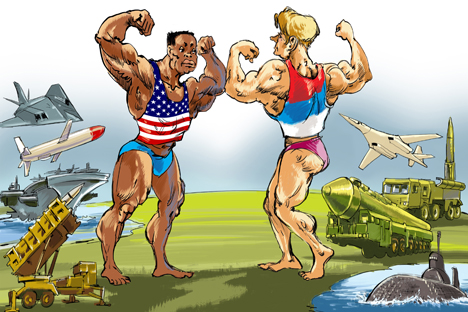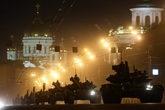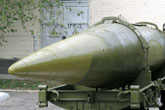Russia and America measure nuclear swords

Drawing by Tatyana Perelygina
In early October, the U.S. State Department released a report on the status of the strategic nuclear forces of Moscow and Washington, received during the data exchange between the two countries under the 2010 Prague Treaty on Measures for the Further Reduction and Limitation of Strategic Offensive Arms (START-3). A number of Russian media outlets reported that Moscow has established parity with Washington on nuclear launchers.
This is not entirely correct, according to the former chief of staff of the Strategic Missile Forces, Colonel-General Viktor Esin. “As for numbers of deployed intercontinental ballistic missiles, submarine-launched ballistic missiles and nuclear-capable heavy bombers, that represent the actual combat potential of strategic nuclear forces, Russia is still way behind the United States,” he told a news agency. “Russia now has 528 of such warheads, while the United States outnumbers it by 266.”
If we read into the official fact sheet, it appears that as of September 1 of this year the United States has 794 deployed intercontinental ballistic missiles (ICBMs), submarine-launched ballistic missiles and heavy bombers, and Russia only has 528. The number of Washington's warheads on deployed launchers is 1642, against Russia's 1643. As for number of deployed and non-deployed launchers it's 912 for the United States and 911 for Russia.
Simple math
To puzzle out the above numbers, one should know that under START-3, by 2018 each party is limited to 700 deployed strategic nuclear launchers (i.e. present in the army and on combat duty) and 100 non-deployed, that is stockpiled. Neither side should exceed the total of 1,550 deployed nuclear warheads. It now becomes clear that the United States should continue reducing its strategic nuclear arsenal, in the first place, the number of deployed strategic missiles, while Russia may increase the number of strategic launchers, reducing the number of nuclear warheads on them, like the United States.
Washington's Minuteman ground ballistic missiles carry one to three nuclear warheads, which explains the approximate equality of nuclear warheads on strategic Russian and American launchers. The United States possesses about 450 of such missiles. But the major nuclear threat comes from the strategic missiles of the Trident-II nuclear submarines, each one of which carries eight multiple independently targetable reentry vehicles (MIRV). USA has 14 Ohio-class submarines, each carrying 24 strategic missiles on board. We are talking about approximately a thousand nuclear warheads, hidden in the depths of the oceans. Then there are 230 strategic bombers of three types - B-52H, B-1B and B-2A (over 50 of them stockpiled). The treaty counts such bomber aircrafts as a single weapon, although the aircraft can carry quite a number of cruise missiles with nuclear warheads as well as nuclear bombs.
National Security
For Russia, the key nuclear objects are concentrated in the Special Reserve Forces. Some are carried by Topol and Topol-M monoblock (one-headed) road-mobile and silo-based weapon systems, which accounted for 186 units, as of January 1, 2014. Some are carried by the Yars road-mobile and the upcoming silo-based systems with independently targetable warheads (MIRV). Currently there are a little over three dozen of these wheeled carriers. Also, some are located on the silo-based systems Voevoda P-36MUTTH \ R-36M2 with 10 MIRV and Stilet UR-100NUTTKH with 6 MIRV, that have 92 missiles on combat duty. In total there are 311 missiles and 1,078 warheads ground-based. For the same period, eight domestic strategic-mission submarines, before the new strategic nuclear Borey-class submarines with Bulava missiles were set on combat duty, accounted for 112 R-29R and R-29M Sineva and Liner missiles with 416 warheads. There are also another 66 TU-95MS and TU-160 strategic bombers.
The above numbers are not meant to demonstrate nuclear parity between Russia and the United States, but to mirror the strategic balance, which pushes Washington to sign a treaty with Moscow on measures for further reduction and limitation of strategic offensive arms.
Russia has no intentions to aim for parity in strategic nuclear weapons with any state. It's committed to adhering to the START-3 treaty and, as the recent SMF trainings proved, maintains its strategic deterrence forces in the high level of combat readiness, not as a threat to anyone, but as a sovereign right to provide its national security and the security of its allies.
All rights reserved by Rossiyskaya Gazeta.
Subscribe
to our newsletter!
Get the week's best stories straight to your inbox

